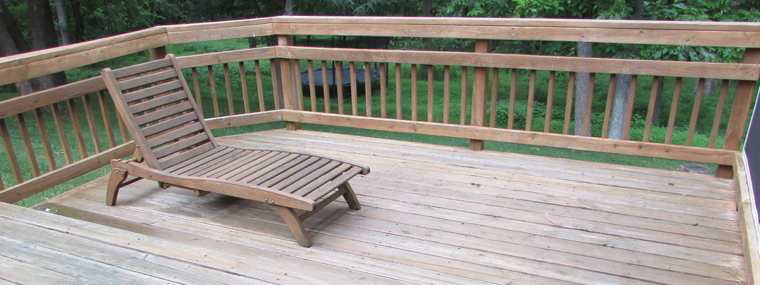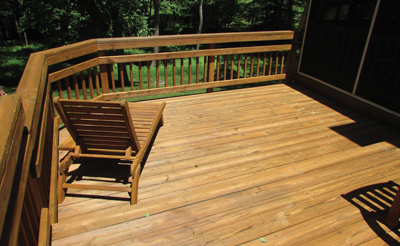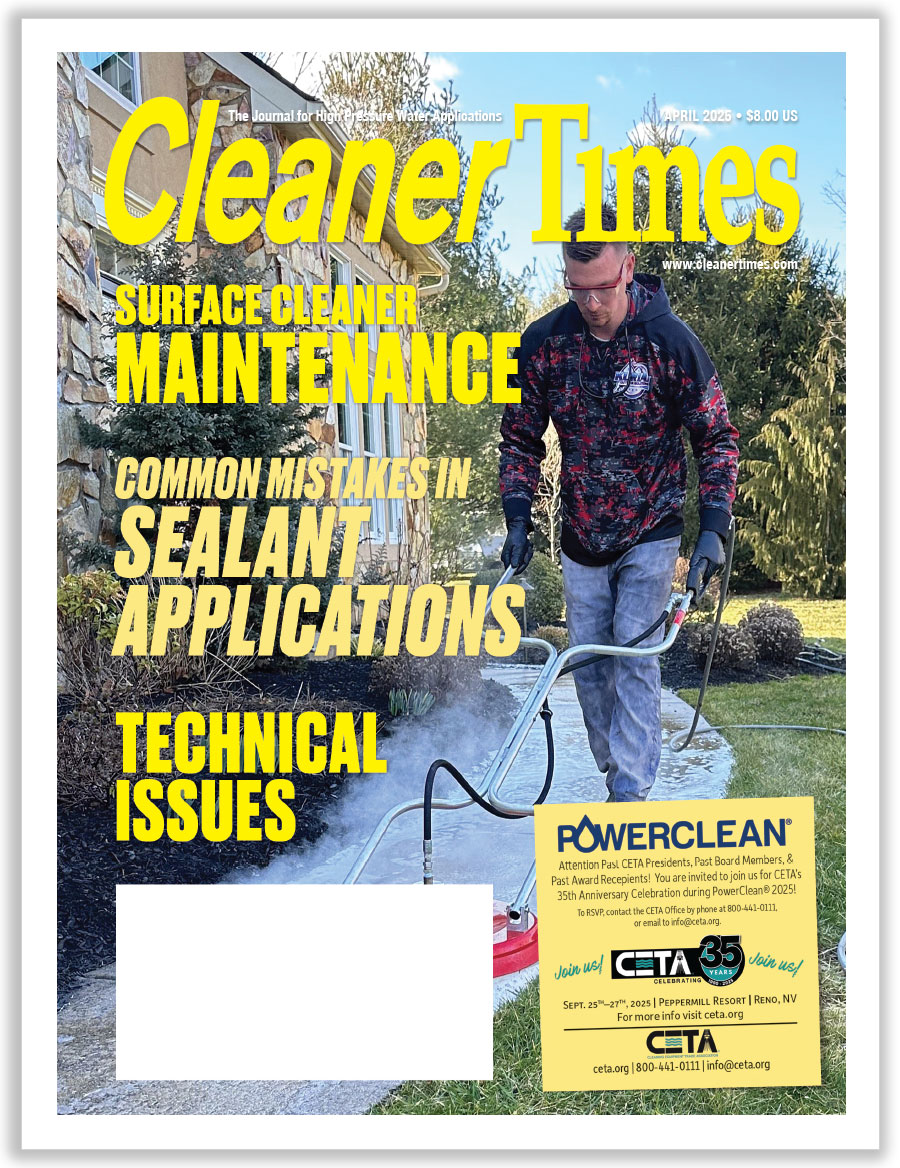
Don’t Forget the Soap When Cleaning and Staining Decks
By Diane M. Calabrese / Published March 2022

Already popular in 2019, deck installations have multiplied dramatically in the last two years. Great space extenders, decks require the same attention as any other part of a dwelling. Slap-dash hose downs and quickly applied coatings diminish the beauty and longevity of decks.
The best staining products are still dependent on the preparation. Get the preparation wrong, and a coating application that follows will not be on a sound footing.
“Using too much pressure or the wrong tools for the job, which could cause splintering of the wood,” is a big mistake often made when cleaning wooden decks, says Breck Tatum, sales representative with Deco Products Inc. in Denver, CO. And it’s not just wooden decks that are vulnerable to mismatches.
Composite decks must also be given careful attention. And so must composite components aligned with some wooden decks. “Be wary of using chemicals that are detrimental to the composite and can cause discoloration due to overspray when used near the composite,” says Tatum.
The place to begin is with a firm knowledge of the substrate. If it’s wood, know the type and its characteristics, says Tatum.
There’s no substitute for getting a firm fix on the type of substrate before doing anything else. The wood species indicates the “correct cleaner or stripper and neutralizer for the specific desk restoration,” says Mike Hilborn, owner of Roof-to-Deck Restoration in St. Paul, MN.
“Believing that high pressure can strip a deck” is a big mistake, says Hilborn. For wooden or composite decks, the process begins with knowing what’s being cleaned. The correct detergent must be used to clean a composite deck.
“Find out the manufacturer of the composite decking in order to contact them and learn what cleaner should be used,” says Hilborn.
Remember that deck manufacturers and installation companies have a vested interest in the appearance and lives of their decks. A good-looking deck is a high-visibility advertisement to neighbors and passersby who might be considering such an addition.
Contractors taking on staining must understand the characteristics of different wood. Hilborn explains the perception of color after staining hinges on the wood. And he firmly advocates for oil-based stain.
It is not a situation where there is an optimal match between a chosen stain and the wood—one that will bring out a certain hue. “There is no matching,” says Hilborn. “Oil-based stain is the only stain to be used on a wood deck. The color is a combination of the wood and the stain color. Water-based is not maintainable.”
Hilborn, too, issues the advisory about overdoing it. “You can damage a wood deck quickly with pressure,” he says. “Gallons per minute with an adjustable wand, along with the correct cleaners, are the tools of the job. The power washer is more or less a rinsing tool.”
With that overview, let’s get some of the details that contribute to the big picture.
Soaps and Other Matters
Too often, says Rod Rodriguez, president of See Dirt Run! Inc. in Germantown, MD, contractors forget that “water alone is not a cleaning agent.” As such, more than the pressure of water is required.
Rodriguez points to the ease with which everyone reaches for dish, laundry, and vehicle soaps or detergents. “We use a soap designed for the job. So why skip that detail when washing a deck?”
Similarly, an approach that does no damage is an imperative. Besides not cleaning, water pressure may damage wood. “The damage inflicted is often to the point of not being reversible,” says Rodriguez.
“Often the scars from too much pressure go deeper than one would want to sand out,” says Rodriguez. Composite is at risk, too, if a contractor relies on “only the pressure washer to do the work.”
Contractors who include decks in their repertoire gain from interacting with manufacturers. They also build a knowledge base from experience and discussions with colleagues.
“Composites are made up of a mix of materials and need to be addressed in respect to what has an adverse effect upon them,” says Rodriguez. “Manufacturers suggest an oxygen-based cleaner like Oxy-Clean or a version that is packaged for that purpose. Just be aware, you may pay more than it is worth and may be better off buying a version off the shelf at your local box store.”
Cleaning once accomplished, other choices await. Some choices depend on geography. Others stem from owner preference.
“Stain, referring to the color, is a personal choice, and once made becomes a commitment to that product for the duration of its life expectancy,” says Rodriguez. “The more important question to be asked is, ‘Which stain product is right for the environment the deck is in?’”
Rodriguez explains that stain (sealer) formulations have evolved over the years. Selection encompasses consideration of not only a product’s capabilities and suitability, but also surrounding elements that will impact its performance. And he gives us a few examples.
“Amenities such as pools, hot tubs, and water features add a significant moisture contribution, which leads to the growth of mold and also shortens the life of the product by producing droplets that when exposed to sun amplify the UV [ultraviolet] effects of the sun and shorten [stain’s] life,” says Rodriguez. He adds that chlorine and other products (e.g., sunscreen, bug repellents) spilled onto the deck can over time affect the appearance of the stain.
Ambient conditions and construction of the deck must be evaluated together. For instance, a deck with little or no ground clearance has restricted air flow beneath. It compensates less for rapid wetting and drying events, explains Rodriguez.
The ultra-low deck may sit atop/close to water when it rains. During a long dry spell, the wood may shrink. “This dynamic is more dramatic than most products, which form a film on the surface for protection, can handle,” says Rodriguez. “Oil-based products fare much better than acrylic, latex, or hybrid formulations do in this dynamic.”
Products for staining are formulated for different regions. “Northeast regions, for example, will have acrylic and hybrid formulations and very little oil-based formulations to choose from,” says Rodriguez.
The formulations vary in durability and maintenance requirements, explains Rodriguez. They must be compatible with the wood and the customer’s expectations.
Stains darken over time. When color shift occurs, it’s a signal to strip and re-stain as part of maintenance, says Rodriguez. Without stripping, the addition of new product and the darkened old product can lead to an uneven appearance.
It’s definitely time for maintenance if there is peeling or cracking of a coating, says Rodriguez. The lifespan of the coating has been reached.
Knowledge Before Service
“With rising costs of wood, wood restoration has never been at such a premium,” says Everett Abrams, owner of Deck Restoration Plus/DRI Enterprises in Shamong, NJ. Extending the life of a wooden structure is a big interest of home-owners and home sellers.
Contractors who venture into the deck market with insufficient knowledge disadvantage themselves, explains Abrams. Learning how to capably offer the service opens parallel opportunities.
“A ‘wood’ customer, be it a deck, log cabin, fence, and more, is a very educated customer,” says Abrams. The customer can gauge the con-tractor’s expertise.
A contractor must be versed in the correct equipment and techniques. Wood restoration requires fine-tuning between type of wood and chemicals.
Moreover, there are controversial issues. One is the use of bleach. “Con-tractors use bleach for everything, but that does not mean they know how to use it on different substrates,” says Abrams.
Bleach generates a lengthy pro and con debate, says Abrams, and so cites only essentials. In short, he sees a place for it.
“We use bleach to remediate the organic growth from the wood; however, the growth actually roots ‘into’ the wood. Bleach reacts with the first thing it comes into contact with and in most cases never gets to the actual root of the growth.”
Abrams says he sees many instances in which there is a reoccurrence of organic growth a few months after the job. “This time, though, it is under the coating, which presents a huge issue.” The wood needs to be stripped, brightened, and restored before re-coating again.
From Abrams’ vantage, the most serious error contractors make in deck cleaning and staining is “hands down, voiding the warranty.” That’s serious.
“Most manufacturers have at least a 25-year warranty on their product against fade, scratching, and in some cases, even labor,” says Abrams. Adherence to their recommendations on how to clean and maintain supports the warranty.

Photos courtesy of Curtis Cathcart of Curt’s Pressure Cleaning. He used Deco Products Inc. SilaCast BES
Yet Abrams sees contractors sharing information on social media that centers around using bleach—bypassing manufacturers’ recommendations and, worse, using bleach incorrectly. (Abrams has seen con-tractors end up with claims against them because they did not follow a manufacturer’s recommendations, thereby voiding the warranty.)
As for stains, Abrams is candid. “There is no perfect product, or we would all be using it.”
The goal is to find the optimal pairing of what’s best for the deck and the appearance sought, explains Abrams. Sometimes what a customer wants is not the “wise choice.”
Clear coating is one example. “Technically we do not use clears outside because of the lack of UV protection in a clear,” says Abrams. “Most are considered naturals and are lightly pigmented and have UV protection.”
How to get to the best pairing? Abrams says to ask about deck use, including traffic and pets (e.g., dogs scrape with claws). Also determine a deck’s age. An older deck “may need to add a little darker tone to a sealer or in some cases use a semi-transparent to address the appearance issue.”
The customer looks at the deck every day. “Keep that in mind,” says Abrams. “Overall, though, a contractor should be trying to steer a customer to a penetrating water or oil-based product that will wear between a two- and three-year period. Anything over three years is usually hard to maintain and causes more work to maintain later.
“This will require you to perform a light cleaning and a maintenance recoating without ever having to
strip it, if the program is adhered to,” continues Abrams. “When film-forming products wear or chip away, the wood is exposed, and there is nothing left of the coating. Penetrating products are the easiest to maintain because the surface wears [and recoating after cleaning replenishes]. This is easiest on the contractor, builds maintenance programs, and keeps the deck looking the same year-round.”
When contractors take on deck cleaning and staining without sufficient knowledge, frustration ensues, explains Abrams. The niche, however, is growing and profitable. So, learn. Then, do.








